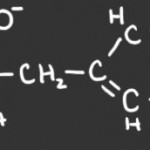Phenylalanine which converts to Tyrosine i s an amino acid that comes in three different forms, which are L, D, and DL. The L-Phenylalanine is the most common form that you will hear about; it is also the only form that is incorporated into your body’s proteins. The D-Phenylalanine form is similar to a painkiller that is the properties that it portrays. The DL-Phenylalanine is a combination of the two different forms, so it is incorporated into your body’s proteins, but it also acts as a painkiller.
s an amino acid that comes in three different forms, which are L, D, and DL. The L-Phenylalanine is the most common form that you will hear about; it is also the only form that is incorporated into your body’s proteins. The D-Phenylalanine form is similar to a painkiller that is the properties that it portrays. The DL-Phenylalanine is a combination of the two different forms, so it is incorporated into your body’s proteins, but it also acts as a painkiller.
Something else to note about Phenylalanine is that no matter what form you are ingesting, phenylalanine is best known for its ability to be converted into another important nutrient, known as tyrosine. Once the phenylalanine is converted into tyrosine, the tyrosine is used to make two different neurotransmitters, which are dopamine and norepinephrine.
Knowing what phenylalanine is converted into and what neurotransmitters are made from tyrosine is important to know because it allows you to understand what phenylalanine is needed for in your body. Phenylalanine is needed to help improve your overall mood, which makes sense because of how closely phenylalanine works with the nervous system. Phenylalanine is also used to help improve memory, but it has also been shown to increase learning abilities. A new feature of phenylalanine that makes it even more popular than before is that it can also be used to help reduce your appetite.
Phenylalanine can also be used to help treat some of the side effects of Parkinson’s disease, mainly because phenylalanine is used to help improve your moods. Studies have been done that show phenylalanine can be used to treat people who are suffering from depression, due to Parkinson’s disease; either form of phenylalanine will help with this. The D-form of phenylalanine can also be used to help people who are suffering from Parkinson’s disease because it can be used to treat the pain of arthritis, mainly because it increases your body’s levels of norepinephrine, dopamine, and epinephrine.
In order to ensure that you do not suffer from a serious deficiency of phenylalanine it is recommended that you take 16 mg per every 2.2 pounds of body weight. To get the recommended dosage of phenylalanine each day you can eat foods that contain the amino acid, such as protein rich foods, but it can also be found in dairy products, lima beans, almonds, and avocados to name a few. If you take phenylalanine supplements, you want to do so carefully because of their mod altering capabilities. Overdosing on phenylalanine from dietary intake is rare, but it can happen from the supplements. The most common side effects that you will not from too much phenylalanine are blood pressure problems, heartburn, nausea, headaches, and in severe cases nerve damage.